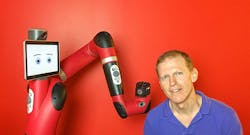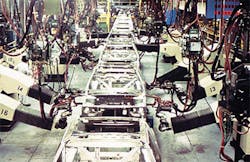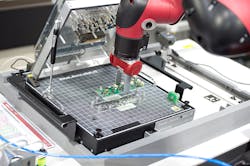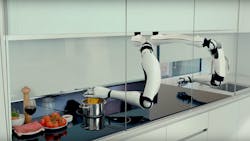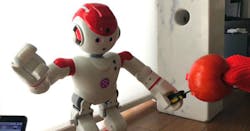When it comes to industrial robots, Jim Lawton has seen them all. From grad school at MIT to managerial duties at Hewlett-Packard factories and now in his role as COO at Rethink Robotics, Lawton has seen the landscape of robotics change. What once were massive, mindless yellow brutes welded into assembly lines are now housed in softer red plastic shells, able to work side by side with humans. Rethink has deployed thousands of its emotive, super flexible cobots, the one-armed Sawyer and two-armed Baxter models, around the world, and Lawton has talked to hundreds of manufacturing execs and workers to find out what they want, what they need, and what scares them about the paradigm shift to smarter, more automated factories. This experience has given Lawton exclusive insights which he has compressed into a series of essays in a new 63-page e-book called Mind + Maker: An Insider’s Perspective on the Robot Revolution in Manufacturing.
Playing the role as an ardent champion of robotics and down-to-earth futurist, the Rhode Island native introduces readers to big picture robotics strategy and technology in a relatable way based on grounded observations. The e-book itself should be required introductory reading for anyone unfamiliar with the current state of the advanced manufacturing, and even the most experienced among us can flip through and find a topic that speaks to them personally.
And we had the chance to speak personally with Lawton himself about what was covered in the e-book, and robotics in general.
John Hitch: What’s the main purpose of the e-book?
Jim Lawton: In regards to cobots, the e-book answers questions like where are the places to use them? What are traditionally some of the stumbling blocks that people have bumped into? If we get robots that can leverage machine learning and artificial intelligence, can we have these robots start suggesting things to us as ways of making their operations better?
What I was trying to do with this was put together a collection of pieces from different vantage points that speak to that. And if I can get people to start thinking about what they should be thinking about, and why they’re not so scary, then I will have done some good.
John Hitch: What’s the basic advantage collaborative robots offer over old-school ones?
Jim Lawton: With traditional industrial robots, you design work cells and production lines and oftentimes you do that in a way that’s tuned for the specific application. What you have in the end is basically a custom implementation of a piece of automation. And that model works really well in certain industries and certain volumes, like if you’re Apple making a million iPhones a day. But if you’re a small or medium company where you need to have rapid product cycles with two months of production and then ramp down again, you need more versatile kinds of automation solutions, where robots can plug into the environment that you already have without sacrificing flexibility.
JH: You’re saying that we need robots to be as flexible as people?
JL: In some ways, people are super flexible. You show them how to do something and then they do it and you show them how to do something different and they can do that. It’s that flexibility that led to this idea that we need robots to work more like that. We need robots that can be much more adaptable to whatever it is I need to do today.
JH: How do you see this cobot revolution improving manufacturing overall?
JL: The operator of that production line knows how that thing works better than anybody else, and sees opportunities to make it better with the hopes of gaining some improvement. But then you put a big rigid inflexible frozen piece of automation in between the operator and his ability to make the change.
Well, if I can create a piece of automation that enables the people who know the processes better than anybody else to consider ideas, make some changes, see how they work and learn from that, you’re going to get this closed loop cycle that is going to allow people to use these kinds of robots to make them better and to make the manufacturing processes that they serve better.
JH: You’ve had a lot of experience yourself on the factory floor. What’s one way you think cobots and machine learning will help on the line?
JL: Well, now you have robots that know when I did the task, this is how long it took. Every single time. And you get the distribution of what that looks like. The robots can then start to inform their human counterparts if the process starts to run a little bit differently, and ask to make changes or implement best practices it has accumulated over time. This is profoundly going to change how manufacturing gets done.
JH: When you mention machine learning, or AI, people often jump to how dangerous letting robots think on their own can be…
JL: I think one of the misconceptions that people sometimes have is that we’re going to take a robot and we’re going to put some artificial intelligence in it, like the capability that you would get out of Watson, and we’re going to end up with a robot that looks like a Terminator.
Many start to extrapolate and jump to conclusions about what that would look like. That isn’t where it’s going to start, and it may never be where it gets to. And frankly, if you talk to most manufacturers, they don’t want a robot thinking on its own, deciding itself what it’s going to do and start to change things in radical ways.
But they do want to introduce AI in a more “bottoms up” kind of way: have the robot doing what you’ve already asked it to do, but just do it in a smarter way, whether that’s making it easier to train or work more efficiently, or making it more capable of diagnosing its own issues or issues going on within the work cell or the production line. The fact that you know AI is going on is almost not visible nor particularly relevant for the user.
JH: One barrier to having robots do doing more human work is we have optimized, dexterous hands, while they have suction cups and claw hands. Do you see when robots could have more humanoid end effectors?
JL: The kind of a highly articulated fingers that are very hand-like today are still relatively expensive and fairly complex to use. Most manufacturers are looking for the simplest hand they can possibly get away with. And that’s how I think we’ve ended up with these two finger grippers and vacuum suction cups picking things up. I think there’s more work to be done there.
A number of our customers 3D-print their own fingers for specific applications. If we’re going to use hands that are more humanlike, we have to drive down some of the costs of the components and some of the sensors. What we’ve done in the meantime – and one of the things that Sawyer is outfitted with -- is this smart tool plate that allows you to essentially create a hand and then pop it on. So, when the hand hooks onto the robot, it tells the robot, “This is what I am; this is how I work.” And then it can learn and share that information with other robots that may not be in the same physical space or have done that task before.
JH: And this can all be open-sourced, with everyone able to be train robots to do new things. Do you think this could be as prevalent for job creation as developing apps or making YouTube videos?
JL: I think so, especially when we start talking about home environments where people could be creating the equivalent of iPhone apps that work on robots that allow it to do things that maybe the original creator hadn’t even considered, but somebody thought, “Hey you know my grandmother is struggling to do this, I’m going to create an app to help her.”
It will start with some of those utilitarian things like getting the coffee out of the microwave or emptying the dishwasher, and it will graduate into more creative things. Our company has 150 people;we’re not going to figure out all the cool stuff to do in the world. But by creating and working with other companies to create platforms that allow everybody to interact with these robots, they are going to become so ubiquitous that everybody’s creating interesting things.
JH: This could be how robots could create jobs, but I still have a bit of skepticism about them creating more jobs than taking them away. Am I wrong?
JL: You’re absolutely right to be skeptical of anybody like me or someone in my role saying this. But when I go into manufacturing environments and ask them what their number one challenge is, it’s just getting people into jobs. We’ve got customers where half of their workforce is temp, not because they want it that way, but because they can’t find enough full-time labor.
I was speaking at an event with several CEOs of manufacturing companies and I asked how many were struggling to get enough labor to do their manufacturing processes, and 100% of them raised their hand. I think these jobs have historically paid very well, but are not particularly interesting to the newer generations.
You ask a typical millennial if they want to be running a CNC lathe and most likely the answer is going to be no, so we’re going to need robots to do some of these things.
Standing in front of a press break all day in a 120°F room where, if I make a mistake and the machine is not appropriately guarded I could lose my hand--not everybody wants to sign up for that.
JH: Can you predict if we’re going to get more or lose more jobs from this robot revolution?
JL: How do we want to embrace that from a societal perspective? Are there education programs or retraining? How do we help people that get potentially stuck in that transition, like a 58-year-old manufacturing worker in front of a CNC lathe who has been doing that task for 35 years?
JH: One last thing: cobots are obviously designed to be safer around people, but then you see how hackers can take them over. Is there still a risk with cobots?
JL: One way to think about robots, even cobots, is that there are no safe robots, only safe applications of a robot. If you want to put a knife in a robot’s hand and tell it to stab somebody, it will. So I think it’s really incumbent upon people who are designing, engineering and interacting with the robots to use these capabilities in safe ways. I can use a circular saw in a bad way and end up with a bad result. There’s always going to be someone who wants to use them maliciously or for nefarious reasons.
But the ability to put more sensors on robots and design them in ways to minimize the chances that bad things happen will help keep people from getting accidentally hurt by some of these newer technologies.











